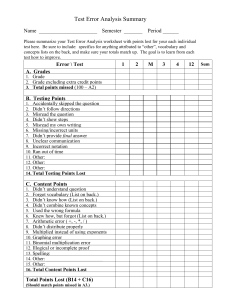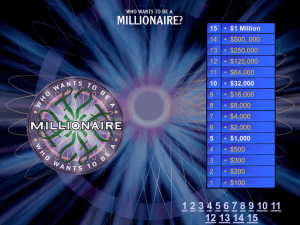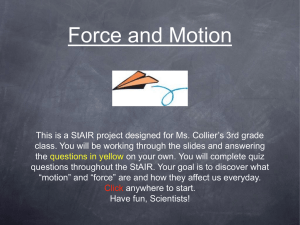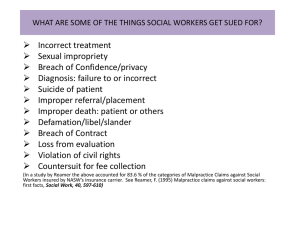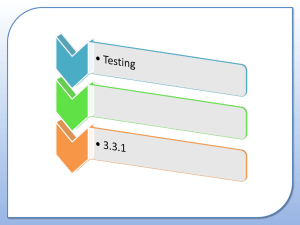Chapter 30: Overview of Green Plants
advertisement
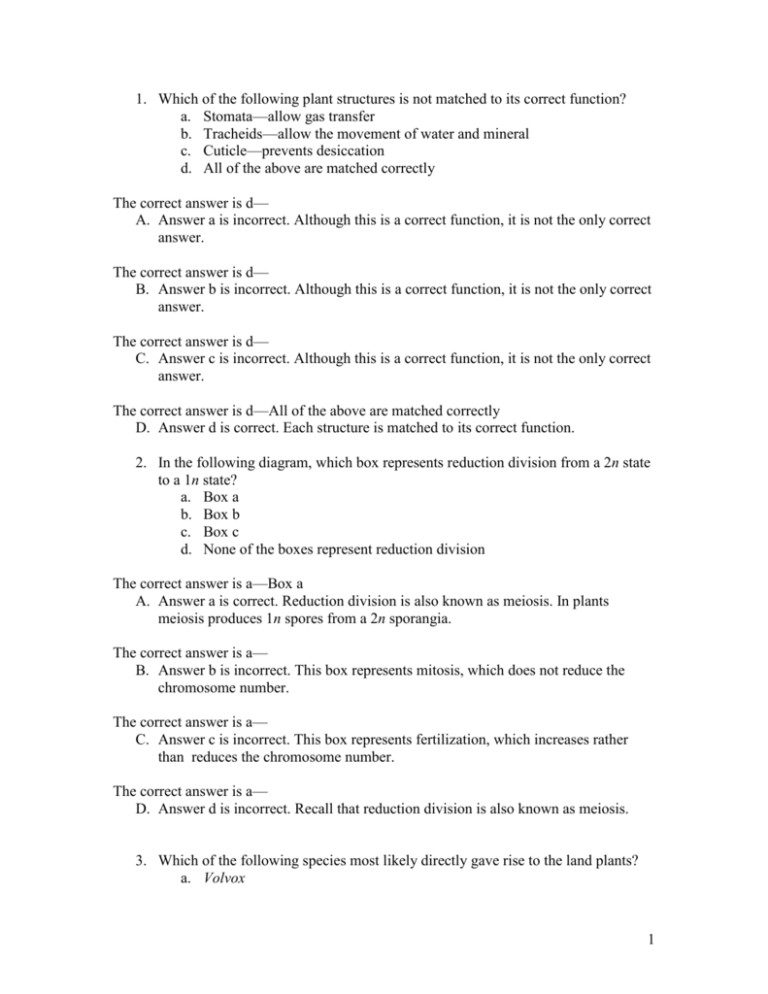
1. Which of the following plant structures is not matched to its correct function? a. Stomata—allow gas transfer b. Tracheids—allow the movement of water and mineral c. Cuticle—prevents desiccation d. All of the above are matched correctly The correct answer is d— A. Answer a is incorrect. Although this is a correct function, it is not the only correct answer. The correct answer is d— B. Answer b is incorrect. Although this is a correct function, it is not the only correct answer. The correct answer is d— C. Answer c is incorrect. Although this is a correct function, it is not the only correct answer. The correct answer is d—All of the above are matched correctly D. Answer d is correct. Each structure is matched to its correct function. 2. In the following diagram, which box represents reduction division from a 2n state to a 1n state? a. Box a b. Box b c. Box c d. None of the boxes represent reduction division The correct answer is a—Box a A. Answer a is correct. Reduction division is also known as meiosis. In plants meiosis produces 1n spores from a 2n sporangia. The correct answer is a— B. Answer b is incorrect. This box represents mitosis, which does not reduce the chromosome number. The correct answer is a— C. Answer c is incorrect. This box represents fertilization, which increases rather than reduces the chromosome number. The correct answer is a— D. Answer d is incorrect. Recall that reduction division is also known as meiosis. 3. Which of the following species most likely directly gave rise to the land plants? a. Volvox 1 b. Chlamydomonas c. Ulva d. Chara The correct answer is d— A. Answer a is incorrect. Volvox is a chlorophyte. This group did not give rise to the land plants. The correct answer is d— B. Answer b is incorrect. Chlamydomonas is a chlorophyte. This group did not give rise to the land plants. The correct answer is d— C. Answer c is incorrect. Ulva is a chlorophyte. This group did not give rise to the land plants. The correct answer is d—Chara D. Answer d is correct. Chara is a charophyte and is the closest link to the land plants on this list. 4. Which of the following would not be found in a member of the bryophytes? a. Mycorrhizal associations b. Rhizoids c. Tracheid cells d. Photosynthetic gametophytes The correct answer is c— A. Answer a is incorrect. Mycorrhizal associations with the fungi are common in the bryophytes. The correct answer is c— B. Answer b is incorrect. Rhizoids are rootlike structures found in some bryophytes. The correct answer is c—Tracheid cells C. Answer c is correct. Tracheid cells transport minerals and water and are not found in the bryophytes, although they have other specialized transport cells. The correct answer is c— D. Answer d is correct. The gametophyte stage of the bryophytes is photosynthetic. 5. Which of the following statements is correct regarding the bryophytes? a. The bryophytes represent a monophyletic clade. b. The sporophyte stage of all bryophytes is photosynthetic. c. Archegonium and antheridium represent haploid structures that produce reproductive cells. d. Stomata are common to all bryophytes. 2 The correct answer is c— A. Answer a is incorrect. Bryophytes are polyphyletic. The correct answer is c— B. Answer b is incorrect. Although the sporophyte stage of a hornwort is photosynthetic, the gametophyte stages of the liverworts and mosses are photosynthetic. The correct answer is c—Archegonium and antheridium represent haploid structures that produce reproductive cells. C. Answer c is correct. These structures are examples of gametangia, the sperm- and egg-producing areas of the gametophyte. The correct answer is c— D. Answer d is incorrect. The liverworts lack stomata. 6. The lack of seeds is a characteristic of all ___________. a. lycophytes b. gymnosperms c. tracheophyte d. gnetophytes The correct answer is a—lycophytes A. Answer a is correct. Club mosses lack seeds. The correct answer is a— B. Answer b is incorrect. Gymnosperms possess seeds, although these are not covered by a fruit. The correct answer is a— C. Answer c is incorrect. Tracheophytes include all plants that possess vascular tissue, this includes the seed plants. The correct answer is a— D. Answer d is incorrect. Gnetophytes possess seeds. 7. Which of the following structures contains the fern sporangia? a. Archegoniua b. Rhizomes c. Phloem d. Sori The correct answer is d— A. Answer a is incorrect. The archegonium is found on the gametophyte. The correct answer is d— 3 B. Answer b is incorrect. The rhizome is the underground stem of the fern. The correct answer is d— C. Answer c is incorrect. Phloem is a form of vascular tissue. The correct answer is d—Sori D. Answer d is correct. Refer to Figure 30.17. 8. Which of the following adaptations allowed plants to pause their life cycle until environmental conditions are optimal? a. Stomata b. Phloem and xylem c. Seeds d. Flowers The correct answer is c— A. Answer a is incorrect. Stomata are involved in gas exchange. The correct answer is c— B. Answer b is incorrect. Phloem and xylem are forms of vascular tissue. The correct answer is c—Seeds C. Answer c is correct. Seeds provide a source of protection and nutrition for a plant embryo. The correct answer is c— D. Answer d is incorrect. Flowers are primarily associated with the attraction of pollinators. 9. Which of the following gymnosperms possesses a form of vascular tissue that is similar to that found in the angiosperms? a. Cycads b. Gnetophytes c. Ginkophyta d. Conifers The correct answer is b— A. Answer a is incorrect. The correct answer is b—Gnetophytes B. Answer b is correct. This tissue is called a vessel. The correct answer is b— C. Answer c is incorrect. The correct answer is b— 4 D. Answer d is incorrect. 10. The drug ephedrine is derived from a species of ___________. a. angiosperm b. cycad c. gnetophyte d. conifer The correct answer is c— A. Answer a is incorrect. Ephedrine is not a product of this group. The correct answer is c— B. Answer b is incorrect. Ephedrine is not a product of this group. The correct answer is c—gnetophyte C. Answer c is correct. Ephedrine is derived from the Ephedra species. The correct answer is c— D. Answer d is incorrect. Ephedrine is not a product of this group. 11. In a pine tree, the microspores and megaspores are produced by the process of _________. a. fertilization b. mitosis c. fusion d. meiosis The correct answer is d— A. Answer a is incorrect. See Figure 30.19. The correct answer is d— B. Answer b is incorrect. See Figure 30.19. The correct answer is d— C. Answer c is incorrect. See Figure 30.19. The correct answer is d—meiosis D. Answer d is correct. 12. Which of the following terms is NOT associated with a male portion of a plant? a. Megaspore b. Antheridium c. Pollen grains d. Microspore The correct answer is a—Megaspore 5 A. Answer a is correct. The megaspore develops into a female gametophyte. The correct answer is a— B. Answer b is incorrect. This is a male structure. The correct answer is a— C. Answer c is incorrect. This is a male structure. The correct answer is a— D. Answer d is incorrect. This is a male structure. 13. Which of the following whorls contains the carpels? a. The sepal b. The androecium c. The gynoecium d. The petals The correct answer is c— A. Answer a is incorrect. Review Figure 20.24. The correct answer is c— B. Answer b is incorrect. Review Figure 20.24. The correct answer is c—The gynoecium C. Answer c is correct. The correct answer is c— D. Answer d is incorrect. Review Figure 20.24. 14. In double fertilization, one sperm produces a diploid ________, and the other produces a triploid ___________. a. zygote; primary endosperm b. primary endosperm; microspore c. antipodal; zygote d. polar nuclei; zygote The correct answer is a—zygote; primary endosperm A. Answer a is correct. The correct answer is a— B. Answer b is incorrect. The primary endosperm is usually triploid, and microspores are not produced by double fertilization. The correct answer is a— C. Answer c is incorrect. Antipodal refers to nonfunctioning egg cells, and zygotes are diploid. 6 The correct answer is a— D. Answer d is incorrect. Polar nuclei are not produced by double fertilization, and zygotes are diploid. 15. Which of the following potentially represents the oldest known living species of Angiosperm? a. Cooksonia b. Chlamydomonas c. Archaefructus d. Ambroella The correct answer is d— A. Answer a is incorrect. Cooksonia was the first vascular land plant. The correct answer is d— B. Answer b is incorrect. Chlamydomonas is a species of green alga (Chlorophyta). The correct answer is d— C. Answer c is incorrect. Archaefructus is extinct. The correct answer is d—Ambroella D. Answer d is correct. Ambroella represents a line of angiosperms dating back almost 135 million years. Challenge Questions 1. You have been hired as a research assistant to investigate the origins of the angiosperms, specifically the boundary between a gymnosperm and an angiosperm. What characteristics would you use to clearly define a new fossil as a gymnosperm? An angiosperm? Answer—Answers to this question may vary. However, gymnosperms are defined as “naked” seed plants. Therefore, an ovule that is not completely protected by sporophyte tissue would be characteristic of a gymnosperm. To be classified as an angiosperm, evidence of flower structures and double fertilization are key characteristics, although double fertilization has been observed in some gnetophytes. 2. What are the benefits and drawbacks of self-pollination for a flowering plant? Explain your answer. Answer—The purpose of pollination is to bring together the male and female gametes for sexual reproduction. Sexual reproduction is designed to increase the genetic variability of a species. If a plant allows self-pollination, then the amount of genetic diversity will be reduced, but this is a better alternative than not reproducing at all. This would be especially useful in species in which the individuals are widely dispersed. 7 3. The relationship between flowering plants and pollinators is often used as an example of coevolution. Many flowering plant species have flower structures that are adaptive to a single species of pollinator. What are the benefits and drawbacks of using such a specialized relationship? Answer—The benefit is that by developing a relationship with a specific pollinator, the plant species increases the chance that its pollen will be brought to another member of its species for pollination. If the pollinator is a generalist, then the pollinator might not travel to another member of the same species, and pollination would not occur. The drawback is that if something happens to the pollinator (extinction or drop in population size) then the plant species would be left with either a reduced or nonexistent means of pollination. 8

